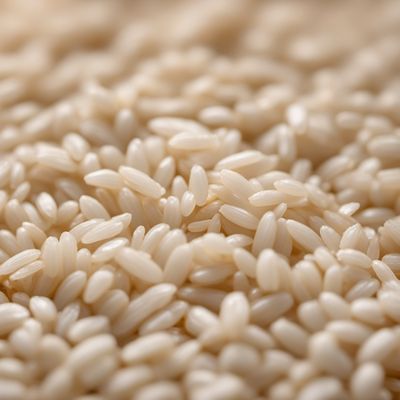
Ingredient
Rice grain, polished
The Shining Jewel of Grains
Polished rice grains are characterized by their smooth, shiny appearance and their ability to absorb flavors and sauces. When cooked, they become fluffy and tender, making them a versatile staple in various cuisines around the world. Polished rice grains are commonly used in dishes such as stir-fries, pilafs, sushi, and rice puddings.
Origins and history
Rice cultivation dates back thousands of years and is believed to have originated in Asia, particularly in regions such as China and India. Over time, rice became a staple food in many cultures and played a significant role in shaping their culinary traditions. Today, polished rice grains are cultivated and consumed globally, with different varieties and cooking methods prevalent in different regions.
Nutritional information
Polished rice grains are a good source of carbohydrates and provide essential nutrients such as iron and B vitamins. They are relatively low in fat and contain no cholesterol. The nutritional content may vary depending on the specific variety of rice.
Allergens
May contain allergens such as gluten in the case of cross-contamination during processing.
How to select
When selecting polished rice grains, look for grains that are uniform in size and have a bright, pearly white color. Avoid grains that appear discolored, broken, or have a musty odor. Opt for reputable brands or sources to ensure quality and freshness.
Storage recommendations
To maintain the freshness and quality of polished rice grains, store them in a cool, dry place in an airtight container. Avoid exposure to moisture, heat, and sunlight, as these can affect the texture and flavor of the rice. Proper storage can help prevent the growth of pests or mold.
How to produce
Polished rice grains can be produced by removing the outer husk, bran, and germ from the rice grain through a milling process. This process results in the characteristic polished appearance of the grains. Rice cultivation requires specific growing conditions, including adequate water supply and suitable climate.
Preparation tips
To cook polished rice grains, rinse them thoroughly to remove any excess starch. Then, combine the rice with water in a pot and bring it to a boil. Reduce the heat, cover the pot, and let the rice simmer until all the water is absorbed. Fluff the rice with a fork before serving. Polished rice grains can be used in a variety of dishes, including stir-fries, pilafs, sushi, and rice puddings.
Substitutions
Brown rice, quinoa, or couscous can be used as substitutes for polished rice grains. These alternatives offer different textures and flavors, but can be cooked and used in similar ways.
Culinary uses
Polished rice grains are widely used in various cuisines around the world. They are a staple in Asian, Indian, and Latin American dishes. Polished rice grains can be steamed, boiled, fried, or used as an ingredient in soups, salads, and desserts.
Availability
Polished rice grains are cultivated and consumed in many countries worldwide, including China, India, Japan, Thailand, the United States, and Brazil.
More ingredients from this category

Rice grain, long-grain
The Elegance of Long-Grain Rice

Rice grain, red
The Vibrant and Nutritious Red Rice Grain

Rice grain, parboiled
The Golden Grain: Unlocking the Secrets of Parboiled Rice

Rice grain, glutinous
The Sticky Wonder: Unveiling the Versatility of Glutinous Rice

Rice grain, brown
The Nutrient-Packed Grain: Brown Rice

Rice grain, mixed
The Versatile Grain
Recipes using Rice grain, polished

Oaxacan Chocolate Halwa
Decadent Oaxacan Chocolate Halwa: A Fusion of Flavors

Hotteok - Korean Sweet Pancakes
Heavenly Delights: Irresistible Korean Sweet Pancakes

Tlingit-Inspired Sago Halawa
Wilderness Delight: Tlingit-Inspired Sago Halawa

Korean Chocolate Rice Cake
Decadent Chocolate Delight: Korean Style Rice Cake

Ugandan Sweet Bread
Savory Delights: Ugandan Sweet Bread - A Fusion of Flavors

Delightful Fruit Medley Salad
Heavenly Harvest: A Burst of Fruity Bliss

Baked Figs in Honey
Honeyed Delight: Baked Figs in Croatian Style